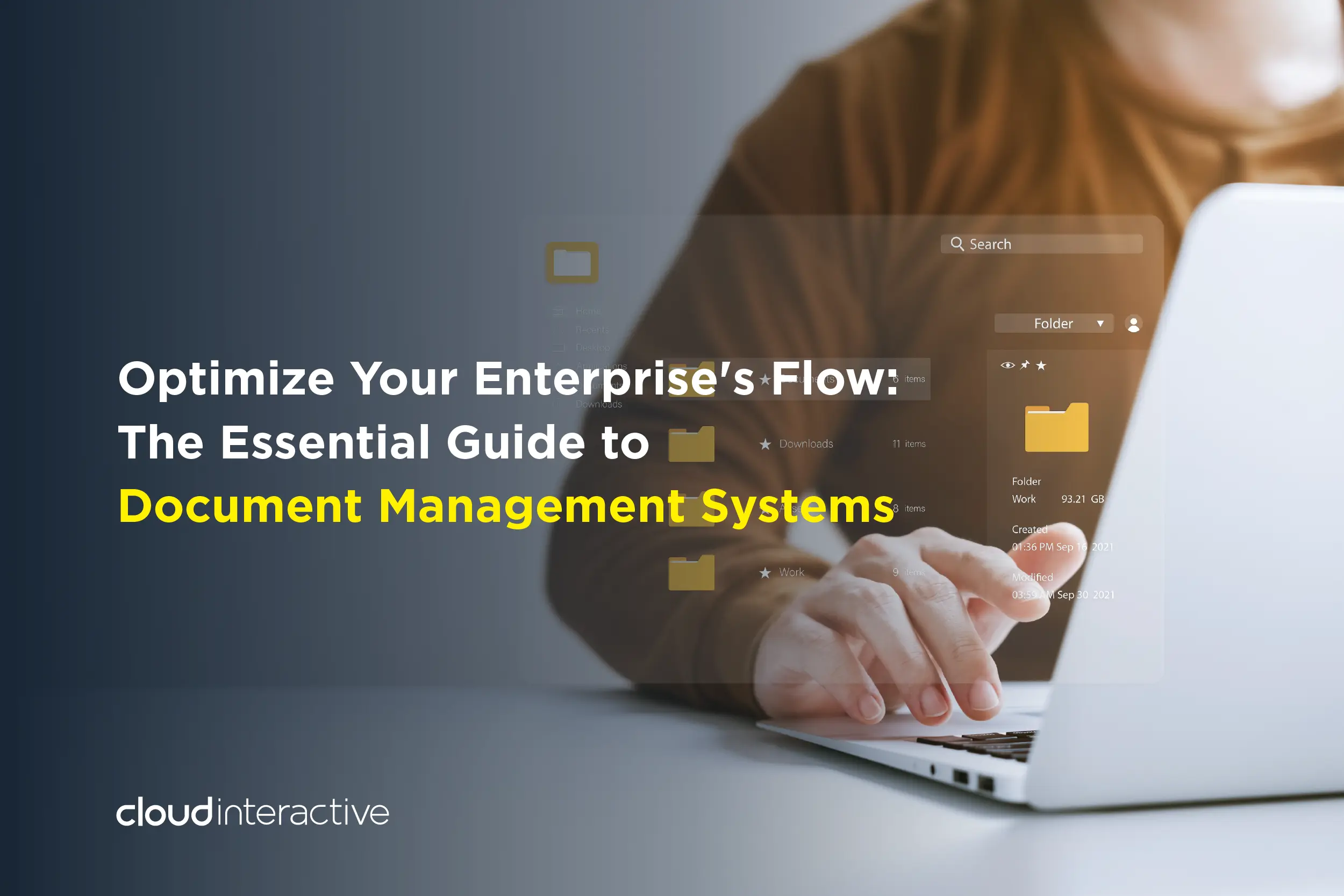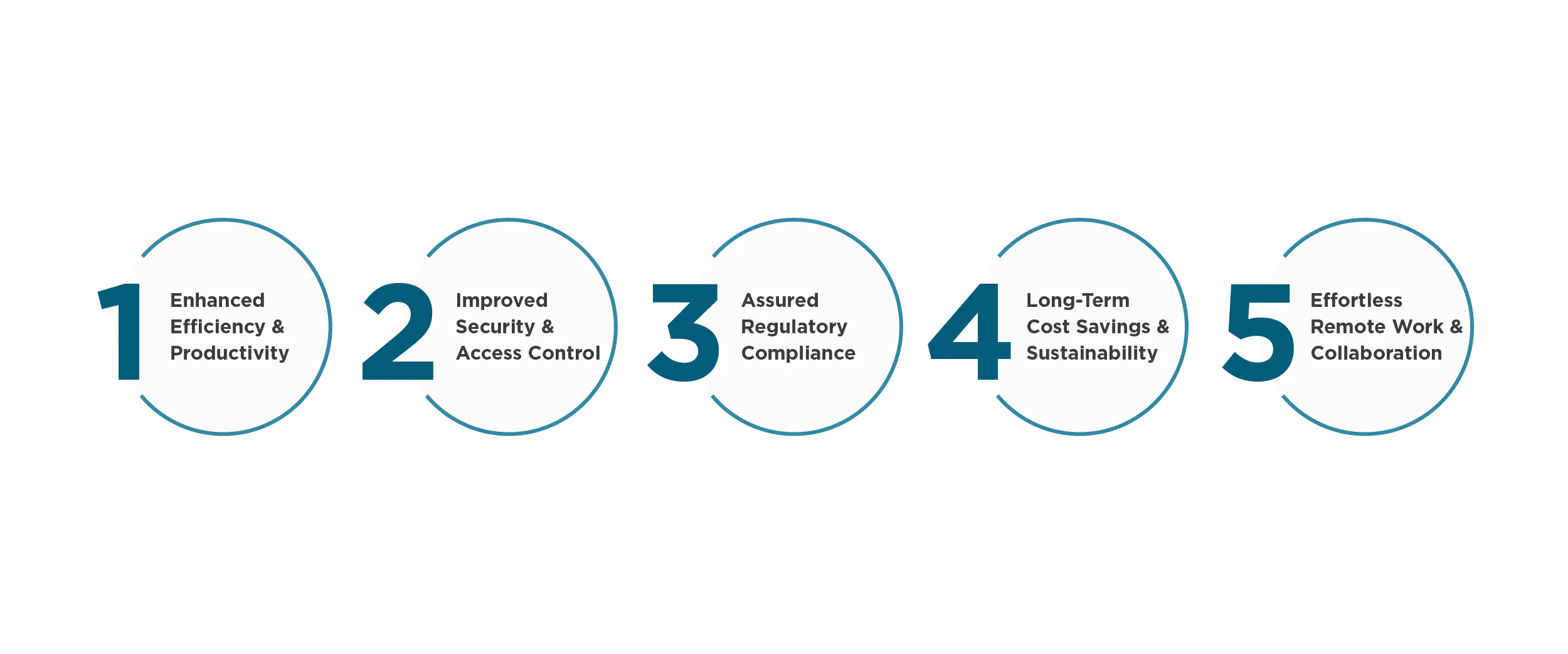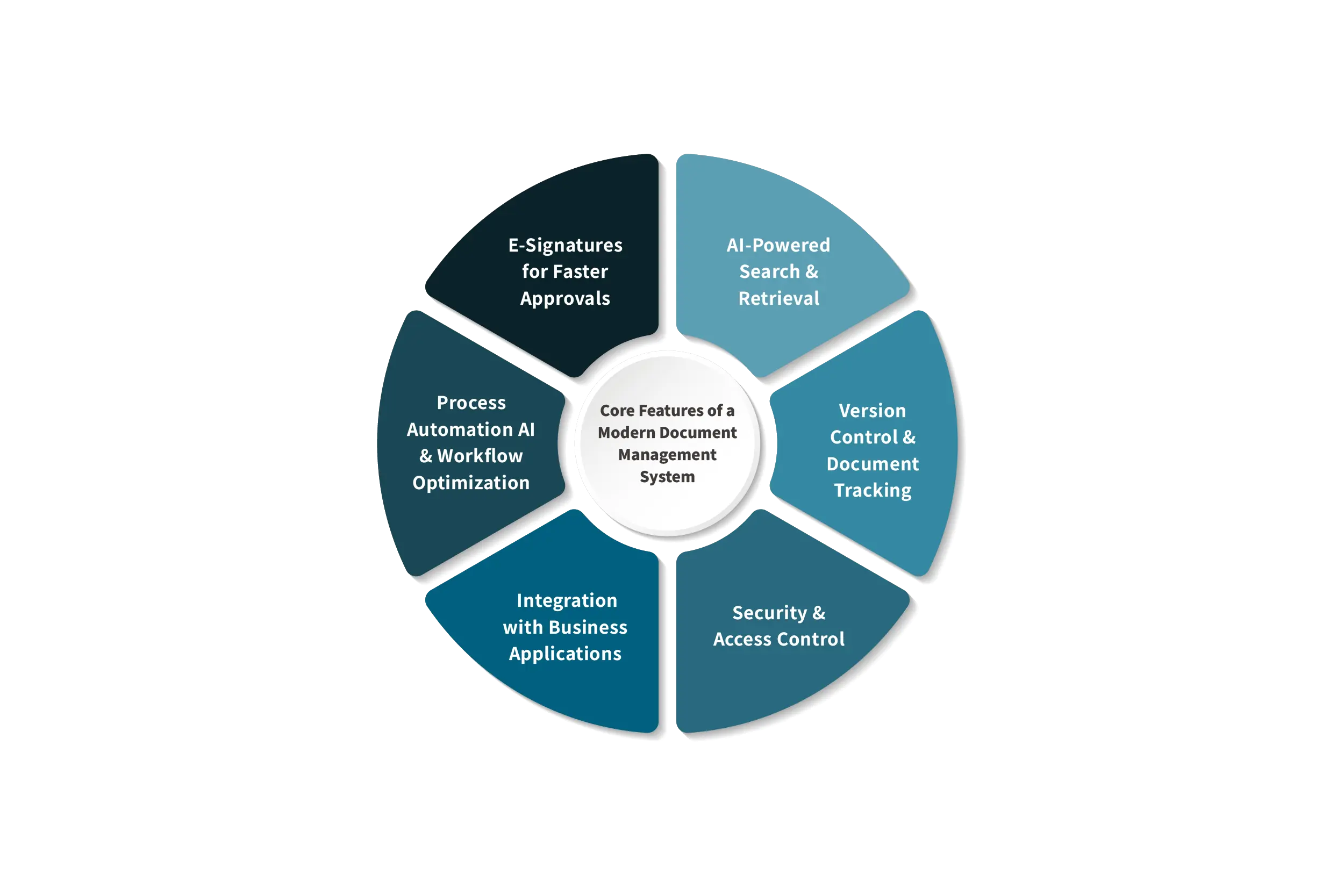
Optimize Your Enterprise’s Flow: The Essential Guide to Document Management Systems
Table of Contents
The Document Management Challenges Businesses Face
Document management refers to the systematic handling of digital files – organizing, storing, and controlling them from creation through to archiving or disposal. It sounds straightforward, but for many enterprises, it’s anything but simple. Here are the hurdles tripping up organizations today:(1) Disorganization Drains Productivity
Nearly half of employees – 48% – struggle to locate documents quickly. On average, they spend 3.6 hours daily searching for files, eroding time that could be spent on higher-value work.(2) Security and Compliance Loom Large
Unauthorized access or data breaches can expose sensitive information, a risk amplified in regulated sectors like finance, healthcare, and legal. Compliance with standards such as GDPR, HIPAA, or ISO 27001 adds another layer of complexity.(3) Manual Processes Slow Progress
Despite digital advances, 72% of organizations still rely on a mix of paper and electronic systems. Manual approvals and outdated workflows introduce delays and errors, stalling operations. For example, a procurement process bogged down by paperwork, email-based approvals, and manual spreadsheet entry faces mounting inefficiencies, blocking businesses with large procurement volumes from scaling or making data-driven decisions.What is a Document Management System?
A Document Management System (DMS) is software designed to store, organize, and manage digital documents efficiently and precisely. Beyond basic storage, today’s document management systems platforms deliver advanced capabilities such as AI-driven document retrieval, version control, access control, and automated workflows.
According to GlobalNewsWire, the global document management system market is expected to reach $24.91 billion by 2032, a clear signal that digital transformation is essential for businesses to stay competitive.

Key Benefits of Using a Document Management System
A well-implemented document management system enhances productivity, strengthens compliance, and cuts costs, delivering measurable benefits. Below, we’ll break down these advantages, backed by insights and data.(1) Enhanced Efficiency & Productivity
47% of digital workers struggle to find documents, and 36% miss critical information due to data overload, according to a Gartner survey. Document Management Systems are centralized, easy-to-use repositories, enabling employees to quickly find, share, and verify the recency of files.(2) Improved Security & Access Control
71% of companies worry that sensitive information is unprotected, risking financial losses and business closure. This is critical in the Banking, Financial Service, and Insurance (BFSI) sectors, which account for 21.7% of DMS usage. Document Management Systems (DMS) reduce these risks by securely managing access to sensitive data, preventing unauthorized access and security breaches.(3) Assured Regulatory Compliance
Businesses often lack confidence in meeting HIPAA requirements, and adhering to GDPR, tax laws, OSHA, and other regulations is challenging. Non-compliance risks legal issues, hefty fines, reputational damage, and financial losses. Document Management Systems simplify compliance by securely organizing and storing files per regulatory standards, minimizing legal risks.(4) Long-Term Cost Savings & Sustainability
Managing paper files is costly and time-consuming, taking up valuable office space and adding to operational expenses. Document Management Systems cut costs by enabling cloud-based storage, eliminating expenses for paper, ink, filing cabinets, and equipment maintenance. Beyond savings, Document Management Software supports paperless offices, reducing waste and aligning with sustainability goals – a smart investment for profitability and corporate responsibility.(5) Effortless Remote Work & Collaboration
In a world where flexible work is the norm, a document management system ensures teams stay connected and productive, no matter where they are. With 77% of businesses accelerating their adoption of digital solutions to support hybrid and remote environments, mobile-friendly access has become a cornerstone of modern workflows. Employees can review, edit, and share documents from anywhere, breaking down geographical barriers and enhancing collaboration.Interested in building your AI-powered document management solution?
Core Features of a Modern Document Management System
The right document management software turns document chaos into control, giving you the power to work smarter. Here are the features to prioritize:(1) AI-Powered Search & Retrieval
Advanced search capabilities are foundational to operational agility. Leveraging artificial intelligence, a modern DMS offers full-text search, metadata indexing, and Optical Character Recognition (OCR) to ensure rapid and accurate document retrieval. This functionality minimizes downtime associated with locating critical files, enabling employees to access information with precision and efficiency.(2) Version Control & Document Tracking
In dynamic, multi-user environments, maintaining document integrity is paramount. Version control provides a comprehensive audit trail, capturing every modification in a centralized repository. This feature supports seamless collaboration across distributed teams and enables reversion to previous iterations as needed, ensuring accountability and continuity in document workflows.(3) Security & Access Control
Data protection is a non-negotiable priority. A modern DMS incorporates multi-layered security protocols, including multi-factor authentication, end-to-end encryption, and role-based access controls, to safeguard sensitive information. Additional features such as watermarking and document expiration settings further enhance intellectual property protection and compliance with regulatory standards.(4) Integration with Business Applications
(5) Process Automation AI & Workflow Optimization
(6) E-Signatures for Faster Approvals
Legal and operational agility depend on swift, secure approvals. Integrated electronic signature functionality ensures that contracts and agreements are executed efficiently, with full compliance to legal standards. By eliminating the need for physical signatures and manual routing, this feature accelerates decision-making and enhances organizational responsiveness in a competitive market.
Choosing the Right Document Management System: Cloud vs. On-Premise
Before implementing a Document Management System, one key decision stands in your way: Where will you store your data? The right choice isn’t universal. Each solution has strengths and niches for different business needs, priorities, and long-term goals. To help you decide, the table below breaks down the key differences between cloud-based and on-premise document management systems:Feature
Cloud-based document management systems
On-premise document management systems
Security
Hosted on third-party servers
Full in-house control
Cost
Lower upfront, subscription-based
Higher upfront, no ongoing fees
Accessibility
Accessible from anywhere
Requires VPN or internal network
Scalability
Easily expandable
Requires additional infrastructure
Example Providers
- Amazon Web Services (AWS)
- Google Cloud
- Microsoft Azure
- IBM Cloud
- Store in company’s own server
- On-premise enterprise storage solutions such as Dell EMC, IBM Storage, and HPE
If speed, flexibility, and remote accessibility are your top priorities, a cloud-based document management system is the way to go. It’s ideal for startups, small and medium-sized businesses, and remote teams that need scalability and agility to support growth.
On the other hand, if security, compliance, and full control over data are non-negotiable, an on-premise document management system is your best bet. Designed for enterprises in highly regulated industries, it offers predictable costs and a controlled environment to meet strict compliance requirements.
Why a Custom Document Management System is the Smart Choice
(1) Designed for Your Workflow
Every business runs differently, yet generic solutions force you into rigid templates. A custom system molds to your exact needs, automating approvals, organizing compliance documents, and ensuring teams work efficiently without workarounds.
(2) Scales as You Grow
Businesses evolve, and your system should too. Custom solutions expand seamlessly, whether you’re adding users, integrating new tools, or managing a growing volume of data. No limitations, no unexpected costs.
(3) Stronger Security & Compliance
(4) Seamless Integration
Your business already relies on tools like CRM, ERP, and collaboration platforms. A custom system connects directly with them, eliminating manual work and frustrating system silos.
(5) Better Long-Term ROI
While off-the-shelf solutions seem cheaper upfront, hidden costs like licensing fees, feature limitations, and IT workarounds add up. Custom document management solutions cut inefficiencies and reduce long-term costs, resulting in better ROI over time.
Best Practices for an Effective Document Management
Mastering document management isn’t just an upgrade – it’s a game-changer. But to make your system truly functional, efficient, and optimized, you need the right approach.
(1) Standardized Naming Conventions & Folder Structures
Disorganized files impede productivity and erode efficiency. Without a systematic approach, locating critical documents becomes a resource-intensive task. Implementing standardized naming conventions and hierarchical folder structures is fundamental to operational success. Establish logical folder frameworks (e.g., “Department > Year > Project”) and enforce uniform naming protocols (e.g., “Report_ClientName_YYYYMMDD”). This methodology accelerates retrieval, enhances consistency, and underpins a robust digital infrastructure.
(2) Automated Document Capture & AI Tagging
Automated document capture, supported by Optical Character Recognition (OCR), and artificial intelligence-driven tagging, makes document management even easier Upon ingestion, the system analyzes content, assigns metadata, and allocates documents to designated categories–such as routing contracts to “Legal” or invoices to “Finance.” This automation minimizes errors, accelerates filing, and ensures a high degree of accuracy and accessibility.
(3) Regular Security Audits & Compliance Reviews
Document management software is a repository of sensitive organizational data, necessitating stringent security measures. Regular audits and compliance reviews are critical to mitigating risksConduct quarterly assessments to maintain system integrity:
- Validate multi-factor authentication (MFA) to prevent unauthorized access.
- Review encryption protocols to ensure data protection at all stages.
- Verify adherence to regulatory frameworks such as GDPR or HIPAA.
(4) Employee Training for System Adoption
No matter how great the system is, your employees are key to the success of digital transformation. Inadequate training undermines system performance and adoption rates, making the workforce reluctant to transit. You can:
- Initiate comprehensive onboarding with structured training sessions to equip employees with essential navigation and operational skills.
- Emphasize standardized practices – such as applying tags like “Urgent” or “Draft” – and reinforce security protocols, including the protection of login credentials.
- Integrate compliance education, detailing obligations under regulations like GDPR and their practical application.
- Supplement initial training with periodic updates to address system enhancements, and incorporate change management strategies to articulate the value proposition – improved workflows and reduced operational friction – enhancing widespread acceptance and proficiency.
Interested In a Custom DMS?
Your tool should fit into your workflow, not the other way around! Cloud Interactive brings 15+ years of expertise in building custom DMS solutions tailored to your workflows, compliance needs, and integrations.
Real-World DMS Success Stories
(1) Fresenius Kabi Optimized Compliance and Efficiency with a Custom Document Management System
Fresenius Kabi, a global healthcare leader in lifesaving medicines, tackled complex document management challenges caused by strict regulations and inefficient handling of clinical, manufacturing, and quality assurance files across multiple sites. By adopting a custom system that automated workflows, secured access, and simplified compliance – featuring version control, audit trails, and centralized storage – allowing staff to find documents instantly, cutting delays, boosting efficiency, and proving how the right document management solution can streamline operations and reduce risks in regulated industries.(2) Premium Home Furniture Wholesaler Transformed Sales with Smart Quotation and Contract Management
If you are struggling to manage – and draft – different types of documents, a Taiwan wholesaler’s approach might inspire you. As a high-end furniture wholesaler in Taiwan, our customer struggled with delays and lost deals due to their manual processes of contracts and quotations; the problem became bigger as their product catalog and customer base expanded. We help them build a digital solution managing quotes, contracts, and various document types. As a result, the company saw a significant improvement in the document management process, enabling sales teams to quickly locate products, generate accurate quotes, and track approvals, eliminating email clutter and paperwork.
Future Trends in Document Management Systems
Document Management Systems are evolving fast, driven by technology, workplace shifts, and the demand for more efficient and intelligent solutions. From AI-powered automation to enhanced security measures, the next generation of systems is set to transform the way businesses manage information. Here’s a look at the key trends shaping the future:(1) AI & Automation in Document Management
In 2025, AI-powered document management systems will take care of sorting, tagging, and organizing files like invoices, contracts, and receipts – reducing manual work and errors. These systems don’t just store documents; they learn from usage patterns. Machine learning improves search accuracy over time, while Natural Language Processing (NLP) makes it easier to find documents using everyday language.(2) Blockchain for Document Verification
Blockchain is transforming document security with cryptographic precision, making tampering nearly impossible. Legal contracts, financial records, and critical business documents can be verified in seconds, ensuring authenticity and preventing fraud.Cloud Interactive: Scalable DMS Solutions for Enterprise Growth
A well-designed Document Management System streamlines workflows, safeguards sensitive data, ensures regulatory compliance, and enhances team collaboration for a more efficient workplace. To build a truly functional system, businesses must first evaluate their document management processes, identify priority features, and choose the right storage solution. By incorporating automation, AI-powered search, and strict security controls, organizations can optimize workflows and maximize productivity.
Off-the-shelf DMS solutions offer basic features but often lack the flexibility and security needed for complex operations. Cloud Interactive brings 15+ years of expertise in building custom DMS solutions tailored to your workflows, compliance needs, and integrations. Our secure, automated, and scalable systems evolve with your business – ensuring long-term efficiency.
By Cloud Interactive
Meet the masterminds behind the curtain at Cloud Interactive. We're not just software developers - we're also a content crew fuelled by caffeine and a thirst for knowledge. We translate tech jargon into plain English, dissect industry trends, and craft helpful tips that are informative and engaging. So, buckle up and join us on a journey through the ever-evolving and exciting world of technology!


